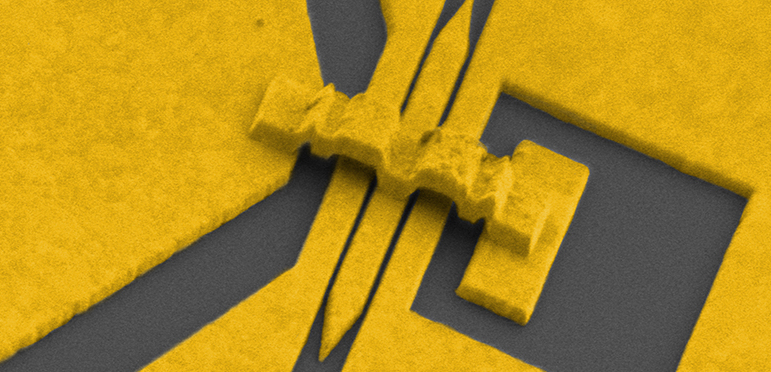Electro-optical modulator is 100 times smaller, consumes 100th of the energy
August 7, 2015

Colorized electron microscope image of a micro-modulator made of gold. In the slit in the center of the picture, light is converted into plasmon polaritons, modulated, and then re-converted into light pulses (credit: Haffner et al. Nature Photonics)
Researchers at ETH Zurich have developed a modulator that is a 100 times smaller than conventional modulators, so it can now be integrated into electronic circuits. Transmitting large amounts of data via the Internet requires high-performance electro-optic modulators — devices that convert electrical signals (used in computers and cell phones) into light signals (used in fiber-optic cables).
Today, huge amounts of data are sent incredibly fast through fiber-optic cables as light pulses. For that purpose they first have to be converted from electrical signals, which are used by computers and telephones, into optical signals. Today’s electro-optic modulators are more complicated and large, compared with electronic devices that can be as small as a few micrometers.
The plasmon trick
To build the smallest possible modulator they first need to focus a light beam whose intensity they want to modulate into a very small volume. The laws of optics, however, dictate that such a volume cannot be smaller than the wavelength of the light itself. Modern telecommunications use near-infrared laser light with a wavelength of 1500 nanometers (1.5 micrometers), which sets the lower limit for the size of a modulator.
To beat that limit and to make the device even smaller, the light is first turned into surface-plasmon-polaritons. Plasmon-polaritons are a combination of electromagnetic fields and electrons that propagate along a surface of a metal strip. At the end of the strip they are converted back to light once again. The advantage of this detour is that plasmon-polaritons can be confined in a much smaller space than the light they originated from.
The modulator is much smaller than conventional devices so it consumes very little energy — only a few thousandth of a Watt at a data transmission rate of 70 Gigabits per second. This corresponds to about 100th of the energy consumption of commercial models. And that means more data can be transmitted at higher speeds. The device is also cheaper to produce.
The research is described in a paper in the journal Nature Photonics.
Abstract of All-plasmonic Mach–Zehnder modulator enabling optical high-speed communication at the microscale
Optical modulators encode electrical signals to the optical domain and thus constitute a key element in high-capacity communication links. Ideally, they should feature operation at the highest speed with the least power consumption on the smallest footprint, and at low cost. Unfortunately, current technologies fall short of these criteria. Recently, plasmonics has emerged as a solution offering compact and fast devices. Yet, practical implementations have turned out to be rather elusive. Here, we introduce a 70 GHz all-plasmonic Mach–Zehnder modulator that fits into a silicon waveguide of 10 μm length. This dramatic reduction in size by more than two orders of magnitude compared with photonic Mach–Zehnder modulators results in a low energy consumption of 25 fJ per bit up to the highest speeds. The technology suggests a cheap co-integration with electronics.